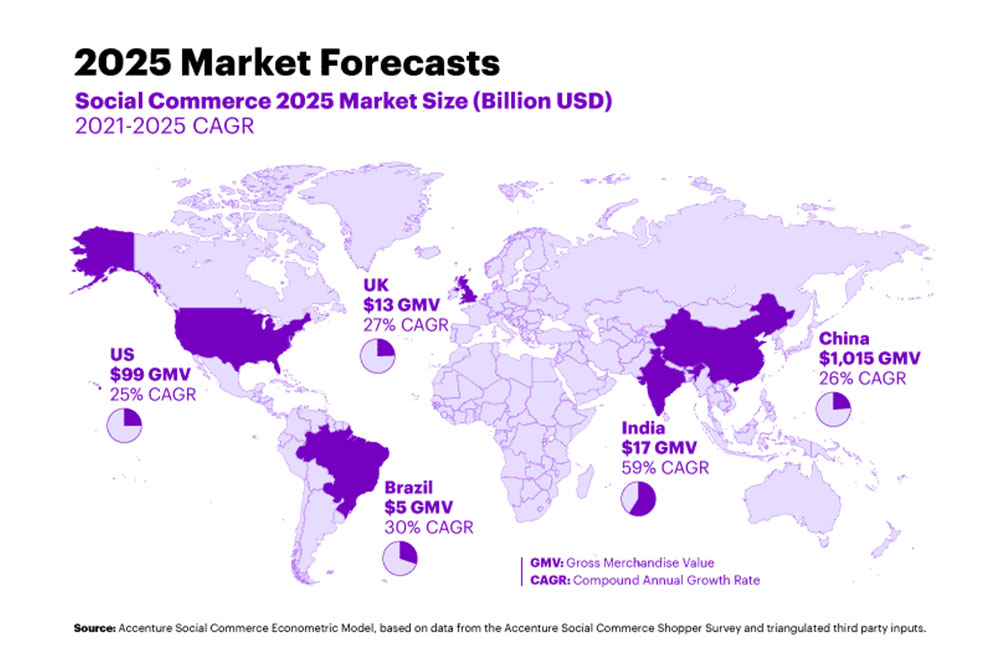Social commerce to reach US$1.2 trillion globally by 2025
According to a new report, ‘Why Shopping’s Set for a Social Revolution‘, released by Accenture on 4th January, global shopping via social media platforms is set to grow three times as fast as traditional e-commerce by 2025 as brands continue to widen their investments into social media marketing and advertising campaigns.
The study, which surveyed 10,053 people, estimates that social commerce will account for 16.7 percent of all e-commerce spend by 2025. With the market for online social commerce set to grow from US$492 billion in 2021 to US$1.2 trillion in 2025, growth is predicted to be driven primarily by Gen Z and Millennial users who will account for 62 percent of global social commerce spend.
China will remain the most advanced market both in size and maturity, yet the highest growth will be seen in developing markets such as India and Brazil. In these markets, social commerce has the potential to leapfrog e-commerce as new business models allow for greater participation in digital commerce across all spectrums of society.

According to the report, clothing is set to be the top social commerce category globally by 2025 (18 percent of all social commerce), followed by consumer electronics (13 percent) and home décor (7 percent). Fresh food and snack items also represent a large product category (13 percent) although sales are nearly exclusive to China. Beauty and personal care, although smaller in terms of total social commerce sales, is predicted to quickly gain ground on e-commerce and capture more than 40% of digital spend on average for this category in key markets by 2025.
Social commerce is a democratising force, opening up new avenues of opportunity for individuals and small businesses. 59 percent of social buyers say that they are more likely to buy from a small business when shopping through social commerce versus online. 44 percent are more likely to buy a brand that they have not previously encountered. 63 percent said they are more likely to buy from the same seller again, showing the benefits of social commerce in building loyalty and driving repeat purchases.
Social commerce is already trending in China. Eight out of ten social media users in China use social commerce to make purchases for a given category. Companies such as Pinduoduo allow communities to group buy products and offer deep discounts to social media users and social reselling platforms such as GlowRoad. Accenture’s research found that in China, 463 million people are already making money through social media. In just one day in October 2021, two of China’s top live-streamers, Li Jiaqi and Viya, sold US$3 billion worth of goods. That is roughly three times Amazon’s average daily sales reported Accenture.
Such predictions mean retailers must embrace the change and leverage the power of social commerce. There are opportunities to develop new types of shopping experiences, connect in new ways and engage influencers/creators.
“While the opportunities are immense, brands must get their basic growth pivots right for a seamless commerce experience that’s relevant and unique for their customers. This includes having a clear vision in activating social commerce, identifying the right business model in terms of where, what and who to sell to, as well as forming the right partnerships from creators, supply chain partners through to technology partners” said Mohammed Sirajuddeen, Growth & Digital Commerce Lead, Growth Markets, Accenture Interactive.
“The acceleration of online shopping has forced retailers to adapt, converging the worlds of social media, e-commerce and advertising. 2022 will be an exciting time to watch the evolution of e-commerce as the lines blur in social media to bring more native experiences that allow consumers to buy where they are. Whether brands seek to develop their own virtual stores, leverage advertising on social media to drive traffic to products, or support their own network of influencers, consumers increasingly want a different relationship with a brand. The need for a well-designed social consumer relationship management system to drive smooth end-to-end shopping experience and deliver timely and conversational customer interactions will be of extreme importance as future of shopping online is social” added Sirajuddeen.
Source: Retail in Asia




